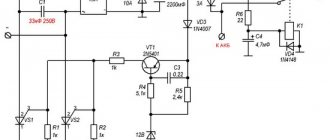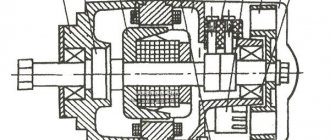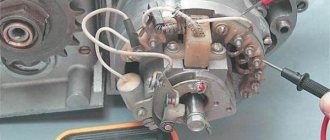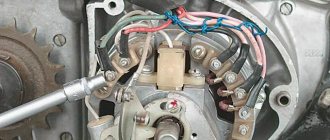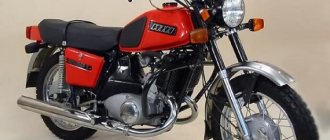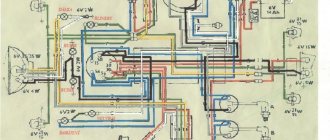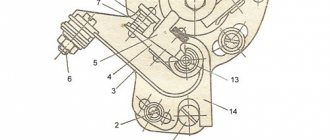What causes a battery to fail?
If the motorcycle is regularly maintained, the battery is recharged slowly and the components are in good condition, the device will last a long time and does not require frequent recharging, but in practice it is not always possible to follow these rules.
Here is a list of factors that have the most negative impact on the wear resistance of a bike’s battery:
- Regular complete discharge of the power supply. If the owner constantly misses the right time to recharge, accelerated sulfation of the plates occurs and the device ceases to hold a charge.
- Overheating of the case or operation at extremely low temperatures - both extremes quickly damage the battery.
- Long-term storage in a discharged state. If you don’t measure the voltage level in time and lay the bike up in this condition, with the onset of the new season you will have to buy a motorcycle battery.
If you ensure timely and correct recharging, avoid overheating of the case and use in extremely low temperatures, the motorcycle power supply can last a long time.
Basic charging rules
In order for the battery to last as long as possible, you need to know how often to charge it, what to use and what parameters of the supplied electricity to set.
Regularity
The frequency of battery recharging depends on its type and operating conditions.
Recharging is performed as the power source discharges. How often is difficult to say exactly, since much depends on driving style, operating conditions and type of battery. Lead-acid batteries, for example, are charged once every 1.5 - 2 months. If the battery has been used for a long time, recharge it every month. Gel batteries are charged 1–2 times a season.
All batteries are prone to self-discharge, that is, they discharge on their own. This process accelerates in the cold, so when you put the motorcycle in the garage, the battery is removed and brought into a heated room.
You should not discharge a motorcycle battery below 30% - this will negatively affect its condition. To check the charge level, use a voltmeter, which is connected to the battery and set to 20 V. The red probe is attached to the “plus”, the black probe to the “minus”. If the measuring device shows 12.3 V, the battery is charged. If 11 - 12.2 V - you need to recharge. Below 11 V – urgent recharging is required to “save” the power source.
Charging time
It depends on many factors. Typically, charging is completed when the voltage reaches double the number of “cans” - 10. When bubbles begin to appear on the surface of the electrolyte, the current is halved and the battery is charged for another 2 hours.
A dry-charged power supply is charged within 9 – 10 hours. A new battery requires less - 3 - 4 hours.
Selecting a charger
There are different charging devices available. In terms of practicality, they are divided into automatic and manual. Automatic ones are easy to use - they themselves select the current strength and monitor the voltage.
Manual ones, they are ordinary ones, are also good, but you will have to monitor the charging progress. A multimeter is used for these purposes. If there is no device, the degree of recharge is determined by the state of the electrolyte.
To charge a gel motorcycle battery, you need a special charger with a current and voltage regulator. These are universal devices that can also be automatic or non-automatic.
Charger for gel batteries.
Many people are wondering whether it is possible to charge a 12 Volt motorcycle battery using a regular car charger. The power supply for a car is characterized by a high capacity, and the charger supplies a current that is unacceptable for charging a motorcycle battery. If there is a current regulator, you can charge; if not, the battery can easily be damaged.
Motorcycle battery condition testing
In order not to miss the moment, you should constantly check the charge level using a special device - a voltmeter.
- We set the indicator to 20 Volts, connect the red probe to (+), and the black one to (-) and watch the readings.
- A value of 12.3 indicates the norm - continue using lightweight vehicles.
- If the indicator is below normal, but above 11, it’s time to charge the power source.
- 9-11 is an indicator of a critical condition; urgent charging is required, but be prepared for the fact that it may not help.
- Below 9 – the battery should be replaced with a new one.
How often should you charge your motorcycle battery?
A motorcycle battery needs to be charged when it is completely discharged. Lead batteries require this procedure every 2 months. Power supplies used for more than 2 years are charged once a month. Gel batteries have the lowest self-discharge. It is enough to service them once every 3 months.
After storage, a power source that has been discharged over the winter should be charged immediately. Don't wait until your motorcycle won't start. A critical discharge negatively affects the performance of the battery. A voltmeter is used to monitor the condition of the power source.
Testing is done like this:
- The indicator is set to 20. The red probe is connected to the positive current terminal, the black one to the negative one.
- Evaluate the reading appearing on the tester screen. The normal value is 12.3. When you receive the number 11.2, you need to urgently start charging. A critical loss of energy is indicated by an indicator of less than 11. Recharging in this case may not help.
Automatic and non-automatic charger for 12V batteries.
Types of batteries for bikes
The answer to the question “ which battery to choose for a motorcycle ” depends on the technical parameters and configuration that the manufacturer determined for each model:
- Lead-acid batteries are used in older models of motorcycles; they are cheap and sold in most specialty stores. The operation of this unit is ensured by liquid electrolyte, the level of which must be constantly checked and, if necessary, topped up, since it tends to evaporate;
- AGM power supplies are suitable for modern models of equipment with advanced electronics. Their structural design consists of positive and negative plates, with fiberglass mats between them. The plates themselves are filled with electrolyte, the advantages of this type are shock resistance and high starting current;
- gel devices. The electrolyte of this type of power supply has silica added, which makes its consistency more dense. Such devices are resistant to full discharges, can operate at a higher load than AGM, they are used for lightweight equipment that requires a lot of energy to operate the electronics;
- Lithium-ion drives are the lightest and most expensive option; they are 80% lighter than lead-acid types, they do not contain acid, and can be installed at a strong angle. Such batteries last a long time, have a low level of self-discharge, and charge quickly.
Charger options for motorcycle batteries
For each type, you should choose native ones or those designed by the manufacturer for a specific charging model: automatic or non-automatic chargers. The second option is cheaper than the first, but the main advantage of the first is that the process does not require constant monitoring: once connected to the network, the device itself sets the desired current level and maintains it throughout the entire time. With a non-automatic option, it is necessary to constantly monitor the state of the electrolyte using a multimeter or visually by unscrewing the plugs.
Types of chargers
Chargers for motorcycle batteries are divided into 2 types:
- Automatic. When using such devices, user control is not required. The control unit regulates the current and voltage throughout the entire cycle. This is convenient in winter when the battery is charged at home.
- Non-automatic. Using such devices, the user is forced to fully monitor the process. This requires a multimeter. In the absence of a tester, the charging progress is monitored visually. The battery is freed from the plugs and the density of the electrolyte is assessed. The main characteristics of budget non-automatic chargers do not differ from those of expensive models.
You need to use the car charger carefully. Car and motorcycle batteries differ in capacity. The former have a higher rate, so the charger supplies a higher current. If such devices are used frequently, the motorcycle's battery may become damaged. The exception is chargers with current characteristics regulators.
Is it possible to charge a motorcycle battery using a car charger?
Gel battery for motorcycles - no. You should resort to this method only as a last resort and very carefully. Since the power of a car power supply is much higher than that of a motorcycle battery, the car charger supplies more powerful current, which can damage the motorcycle power supply. It is best to choose a native device in specialized stores so as not to take risks, but if the situation is urgent, you can charge the motorcycle battery with a car charger .
Car or motorcycle charger, be careful...
In general, we believe that the current supplied by the charger should not exceed 1 tenth of the battery's capacity. . In other words, a 10 Ah (amp/hour) battery should not receive more than 1 A of current. For this reason, car chargers are rarely suitable for motorcycles , scooters, ATVs and other light recreational vehicles; their excessive current will quickly reduce the battery's capacity when low current.
For example, a motorcycle battery can provide from 3 Ah for a Honda 125 CG to 8 Ah for a Kawasaki Z750 and up to 16 Ah for a Yamaha V Max , find out more. For comparison: a car battery, such as a diesel Golf, provides 80 Ah. Therefore, it is clear that the capacity of chargers is individual for everyone, and rarely for everyone.
For its part, in recovery mode, that is, in the first phase before clean charging, Tecmate Optimate 3 can generate up to 16 V and a current limited to 0.2 A for heavily discharged and / or sulfated batteries (within reasonable limits), or even 22 V in "Turbo" mode or 0.8 A pulses. Next, the actual charging starts from a constant current of 1 A to a maximum voltage of 14.5 V. . Therefore, it is a slow charge, lasting several hours, that is most effective for fully recharging without damaging the motorcycle battery.


